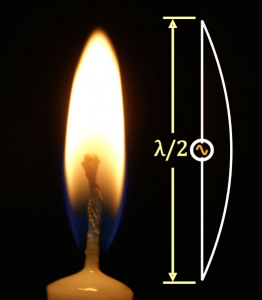- +1 919 200-0292
- info@antennatestlab.com

What Is Antenna Gain ?
What Is Antenna Gain ?
And what are “dBi” and “dB” ?

Imagine an antenna that radiates energy equally in all directions, much like a candle. OK, forget the small shadow under the candle. In scientific lingo, this is said to be an “isotropic radiator”, because it has no preference for radiation in any direction … in other words it has no “directivity”. An isotropic antenna is said to have “no gain”. “No gain” can be expressed in linear terms like x1 (times 1). That simply means that all directions have the same energy radiation, and are all equal to the average energy radiation. Antenna engineers like logarithmic terms, and we say this no-gain situation is 0 dBi (pronounced “zero dee bee eye”).

Now imagine a mirror beside our candle. Visualize how it would change the light energy distribution, and give the candle directivity. With a mirror, one half of the room would be dark (behind the mirror). The other half of the room would be TWICE as bright, because you can see the real candle PLUS it’s reflection. Mirrors or lenses have the appearance of intensifying energy in some preferred directions by stealing and redirecting energy from disadvantaged directions.
Antennas do the same thing. Mirrors don’t create light, they only divert, direct, or concentrate it in some direction. Antennas don’t create radio energy, they also only divert, direct, or concentrate it in some direction. This is directional feature is called GAIN. Please remember, no new energy is created, it is simply redirected or given directivity. The amount of intensification in a preferred direction is quantified as gain. Thus a mirror can redirect half of the energy from a candle, and make it look twice as bright (i.e. two candles) in some directions (but not all directions). It is said to have a gain of 2x (times two) or doubling.
Want to know how much antenna gain you need? (We get asked that all the time.) … then this article is for you:
The Logarithmic dB Scale
Antenna engineers use a logarithmic scale to express this apparent 2x (times two) mirror power doubling as “+3 dBi”. It still means “doubling”. Here are some other examples of ratios or multipliers on the engineering dBi gain log scale.
| Gain in dBi | Meaning |
|---|---|
-10 dBi |
One tenth or 10 % (loss) |
-6 dBi |
One quarter or 25 % (loss) |
-3 dBi |
One half or 50% (loss) |
0 dBi |
Same or 100% (no gain/loss) |
+1 dBi |
12% higher or x 1.12 |
+2 dBi |
58% higher or x 1.58 |
+3 dBi |
100% higher or double |
+6 dBi |
4x higher or quadruple |
+9 dBi |
8x higher |
+10 dBi |
10x higher |
+13 dBi |
20x higher |
+20 dBi |
100x higher |
Evaluate Your Antennas
We are ready to help, just tell us about your project and partner with our antenna testing service.
